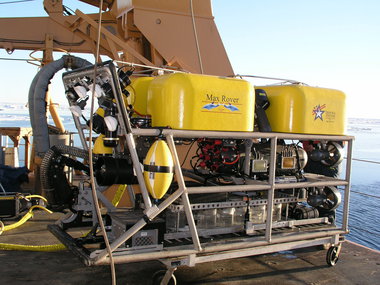The Habitat
In the deep water south of the NGA LTER study area lies an abyssal plain punctuated by volcanic seamounts – mountains that rise from the sea floor. The seamounts provide rocky, hard substrate that makes a good habitat for cold-water corals and sponges. Above the seamounts, ocean currents upwell nutrients to the surface where they feed planktonic organisms. This productivity attracts fish and seabirds to create relative hot-spots of biodiversity in the open ocean.

The Expedition
Immediately following the NGA LTER’s RV Sikuliaq cruise, summer 2019, several of our team members are setting out to extended our knowledge of the Gulf of Alaska. Dr. Russ Hopcroft, Dr. Petra Lenz, Dr. Vittoria Roncalli, Heidi Mendoza Islas, Callie Gesmundo, and Caitlin Smoot are joining our collaborators from Microcosm and other expedition members aboard R/V Sikuliaq to investigate seamounts in the Gulf of Alaska from an ecological perspective.

The ROV Global Explorer is a critical tool of this expedition. Operated by Oceaneering International, the ROV will take video and still images of organisms on the sea floor; this is the least-invasive method of sampling communities that could be damaged by bottom trawls and other collection methods. ROV Global Explorer will also collect fragile jellyfish by gently enclosing them in a sampler. This avoids the bias of previous sampling towards hard-shelled organisms that survive net tows.
Expedition Gulf of Alaska Seamounts 2019 will even be employing DNA sequencing to identify microbes. Previously, a NOAA Office of Ocean Exploration and Research expedition to the Gulf of Alaska seamounts in 2002 found that the corals there were distinct habitats for microbes.
Follow Along
The NOAA Office of Ocean Exploration and Research has created a website where visitors can follow the Mission Logs. Additionally, educators can also learn more about the expedition purpose and find videos and other classroom materials.

NOAA Office of Ocean Exploration and Research funds this project, with additional ship support by the National Science Foundation and the University of Alaska Fairbanks. Science partners during this mission include scientists from the University of Alaska Fairbanks, the University of Manitoba Canada, the Japan Agency for Marine-Earth Science and Technology (JAMSTEC), the University of Hawaii, University of Barcelona Spain, Lamont Doherty Earth Observatory at Columbia University, the U.S. Fish and Wildlife Service, and a Microcosm film team from Montrose Pictures. The partner for the ROV is Oceaneering.
